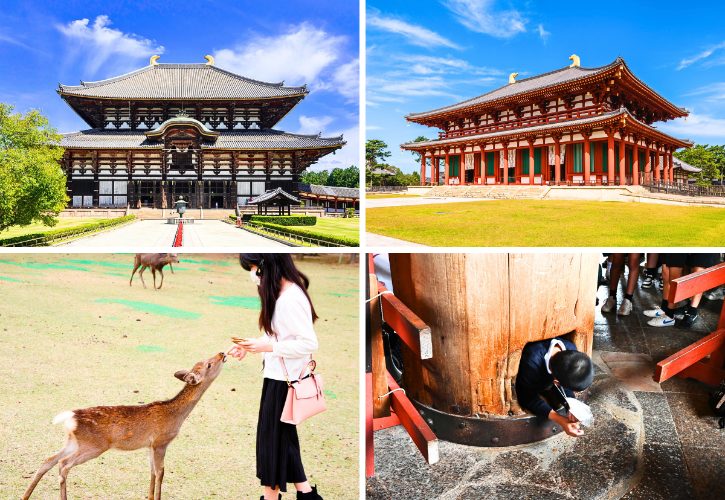
A day trip to Nara from Osaka or Kyoto is essential for travelers seeking to experience Japan’s historic charm.
In this guide, I’ll provide detailed information on how to conveniently travel from either city to Nara, along with the best route to effortlessly explore this captivating destination.
I’ll also guide you step-by-step through Nara’s iconic attractions, ensuring you make the most of your day tour.
Without further ado, let’s dive in. I hope you enjoy this guide! 😊
How to Get to Nara from Osaka
1. By JR Yamatoji Rapid Train
a. Overview
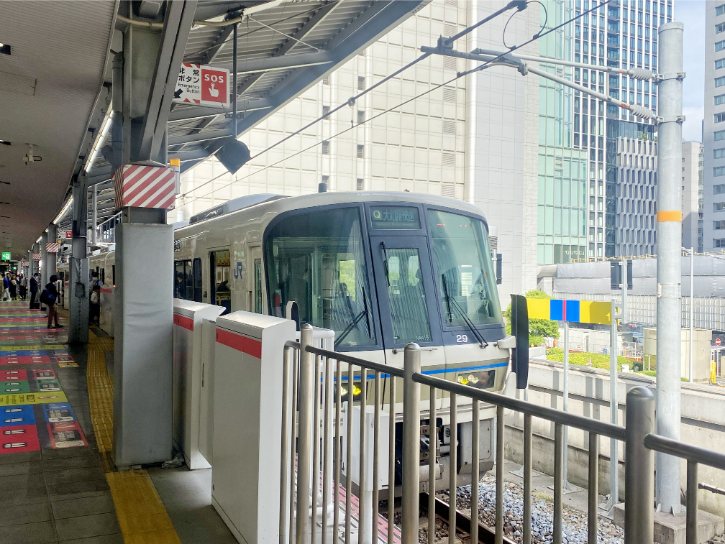
- Weekday Travel:
- Before 9:42 AM, there’s no direct JR Yamatoji Rapid train from Osaka Station to JR Nara Station.
- Take the JR Osaka Loop Line from Osaka Station to Tennoji Station, then transfer to the JR Yamatoji Rapid train to JR Nara Station.
- Direct trains from Osaka Station start from 9:42 AM onwards.
- Weekend Travel: Direct JR Yamatoji Rapid trains from Osaka Station to JR Nara Station start around 7:40 AM.
- Travel Time: Around 50 minutes.
- Cost: A one-way ticket costs is ¥820.
- First Train Departure:
- JR Yamatoji Rapid: The first Yamatoji Rapid train departs from Osaka Station at 9:42 AM (weekdays) and 7:40 AM (weekends).
- JR Osaka Loop Line: The first local train departs from Osaka Station at 5:32 AM.
- Check train schedules in real-time using the Japan Travel by Navitime website.
- IC Card Usage: You can use IC cards like ICOCA or Suica to pay for your fare on the JR Yamatoji Rapid Service. Simply tap your card at the ticket gates when entering and exiting the stations.
- Japan Rail Pass: This service is fully covered by the Japan Rail Pass.
b. Traveling from JR Nara Station to Major Attractions
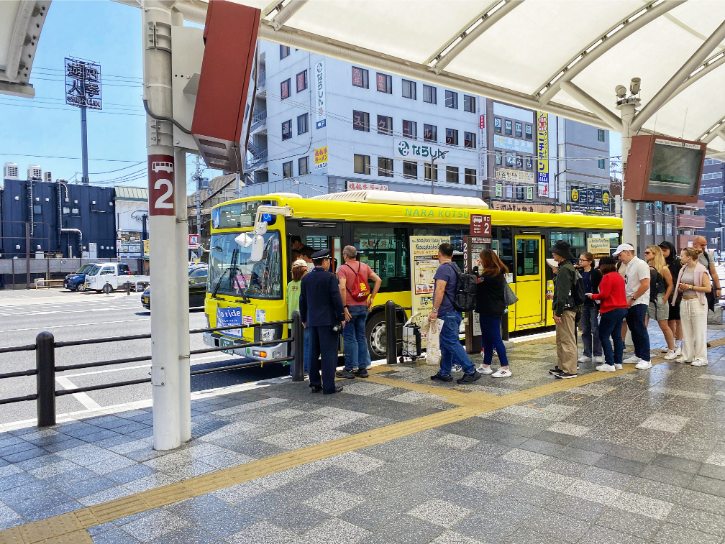
- Distance: JR Nara Station isn’t close to major temples like Kohfukuji or Todaiji.
- Recommended Buses: Use Nara City Loop Bus #2 (¥600 for a day pass) or public bus #77 (¥250 one-way).
- Payment Method: Pay exact fare with cash (no change given) or use ICOCA/Suica cards.
- Travel Time: Around 9–11 minutes to reach Kohfukuji and Todaiji Temples.
- Alternative Station: Kintetsu Nara Station is closer to major sights (explained below).
2. By Kintetsu Nara Line Rapid Express Train
a. Overview
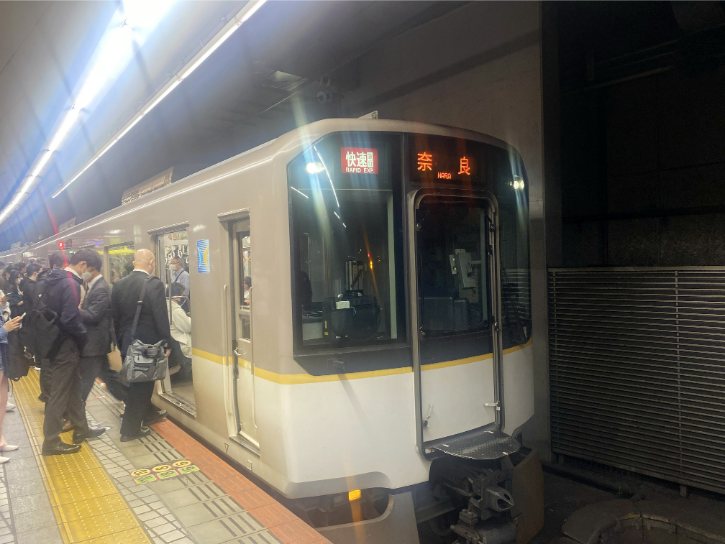
- Route: Take the Kintetsu Nara Line Rapid Express train directly from Osaka-Namba Station to Kintetsu Nara Station.
- Travel Time: Around 35-40 minutes.
- Cost: A one-way ticket costs is ¥680.
- First Train Departure: The first Kintetsu Nara Line Rapid Express train departs from Osaka-Namba Station at 6:38 AM on weekdays and 6:09 AM on weekends (confirm exact time online).
- IC Card Usage: ICOCA, Suica, PASMO, and other IC cards accepted; ensure sufficient balance before boarding.
- Japan Rail Pass: Not accepted on Kintetsu lines.
b. Traveling from Kintetsu Nara Station to Major Attractions
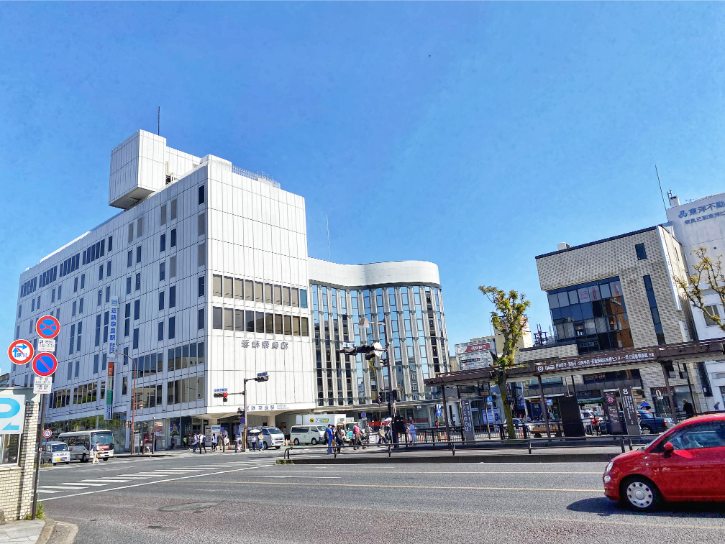
- Distance: Kintetsu Nara Station is conveniently close to major attractions like Kohfukuji Temple and Todaiji Temple.
- Recommended Buses: From Kintetsu Nara Station, take the Nara City Loop Bus #2 (¥600 for unlimited rides for one day) or local buses #77 or #97 (¥250 one-way) to reach Todaiji Temple.
- Payment Method: Pay exact fare with cash (no change given) or use IC cards like ICOCA or Suica.
- Travel Time: Around 5 minutes on foot to Kohfukuji Temple; around 8 minutes by bus to Todaiji Temple.
How to Get to Nara from Kyoto
1. By JR Nara Line
a. Overview
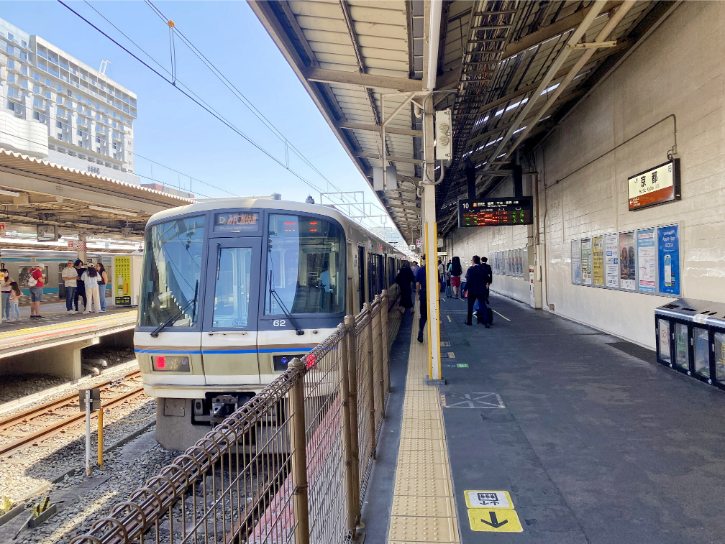
- Route: Board the JR Nara Line at Kyoto Station bound for JR Nara Station. The line offers two types of trains: Local and Miyakoji Rapid services. For the fastest journey to JR Nara Station, choose the Miyakoji Rapid trains, which make fewer stops.
- Travel Time: Duration varies depending on the train type:
- Miyakoji Rapid: About 44 minutes.
- Local Trains: About 70 minutes.
- Cost: A one-way ticket from Kyoto to Nara costs ¥720 for all train types.
- First Train Departure:
- Miyakoji Rapid: The first Miyakoji Rapid train departs at 9:37 AM (weekdays) and 9:07 AM (weekends).
- Local Train: The first local train departs at 5:33 AM on weekdays and weekends.
- It’s best to check the latest train schedules here.
- IC Card Usage: IC cards such as Suica, ICOCA, or Pasmo can be used to ride the JR Nara Line.
- Japan Rail Pass: The JR Nara Line is covered by the Japan Rail Pass.
b. Traveling from JR Nara Station to Major Attractions
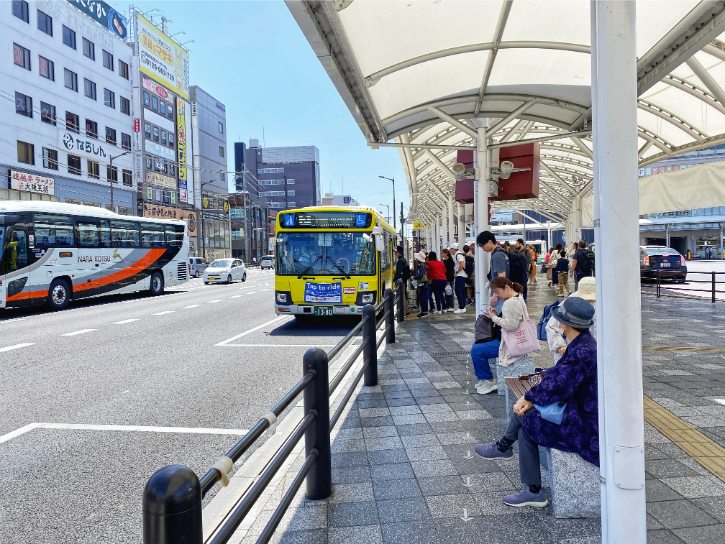
- Distance: JR Nara Station isn’t very close to main attractions like Kohfukuji or Todaiji.
- Recommended Buses: From JR Nara Station, you can reach Kohfukuji or Todaiji by taking the Nara City Loop Bus #2 (¥600 for a 1-day unlimited pass) or local city buses such as #77 or #97 (¥250 one-way).
- Payment Method: Pay with exact cash (no change provided) or use an ICOCA or Suica card.
- Travel Time: It takes about 9–11 minutes to get to Kohfukuji and Todaiji Temples.
- Alternative Station: Kintetsu Nara Station is closer to most attractions (explained below).
2. By Kintetsu Kyoto Line
a. Overview
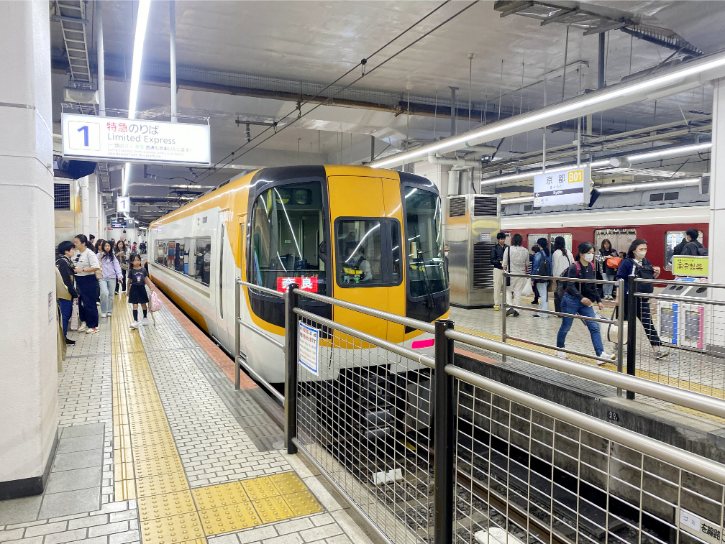
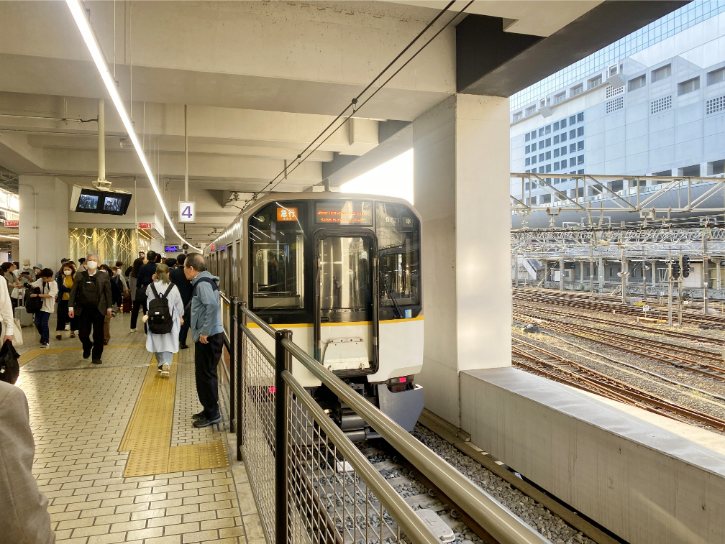
- Route: Take the Kintetsu Kyoto Line from Kintetsu Kyoto Station to Kintetsu Nara Station. Kintetsu Kyoto Station is located on the second floor, on the south side of the main Kyoto Station building.
- Train Options:
- Express Train: Cheaper but slower, with no seat reservations required. (Easy and best for travelers)
- Limited Express Train: Faster, with reserved seating.
- Travel Time:
- Express Train: Around 45 minutes.
- Limited Express Train: Around 35 minutes.
- Cost:
- Express Train: A one-way ticket costs ¥
- Limited Express Train: A one-way ticket costs ¥1,280.
- First Train Departure:
- Express Train: Departs as early as 6:14 AM on weekdays and 9:53 AM on weekends.
- Limited Express Train: First departure is at 7:50 AM on weekdays and 7:55 AM on weekends.
- Check the latest Kintetsu Kyoto Line schedules here
- IC Card Usage:
- Accepted Cards: ICOCA, Suica, PASMO, and similar IC cards can be used.
- Express Train: Tap IC card directly at gates when entering and exiting.
- Limited Express Train: Buy a basic fare and Limited Express ticket at station counters or dedicated machines labeled “Limited Express Tickets”. IC cards are accepted. Advance purchase is recommended, especially during busy periods.
b. Traveling from Kintetsu Nara Station to Major Attractions
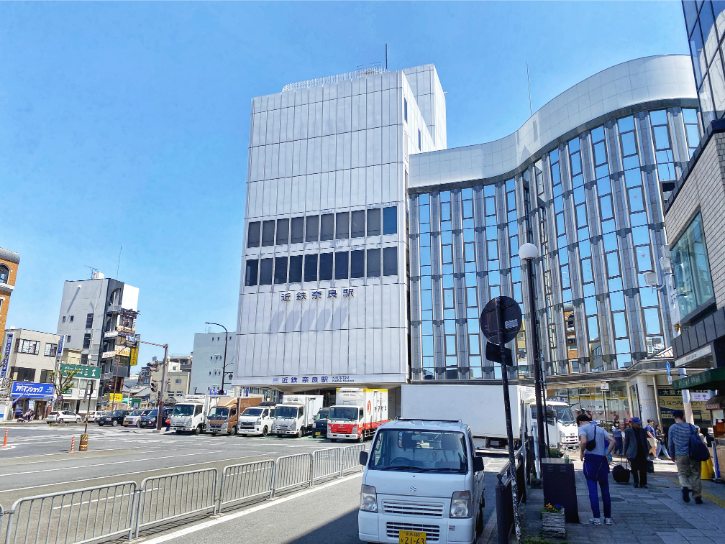
- Distance: Kintetsu Nara Station is close to popular spots like Kohfukuji Temple and Todaiji Temple.
- Recommended Buses: From Kintetsu Nara Station, you can take the Nara City Loop Bus #2 (¥600 for unlimited rides per day) or local buses #77 or #97 (¥250 one-way) to get to Todaiji Temple.
- Payment Method: Pay with exact cash fare (no change available), or use IC cards such as ICOCA or Suica.
- Travel Time: It’s about a 5-minute walk to Kohfukuji Temple, and about an 8-minute bus ride to Todaiji Temple.
9:30 AM: Kohfukuji Temple
a. Overview
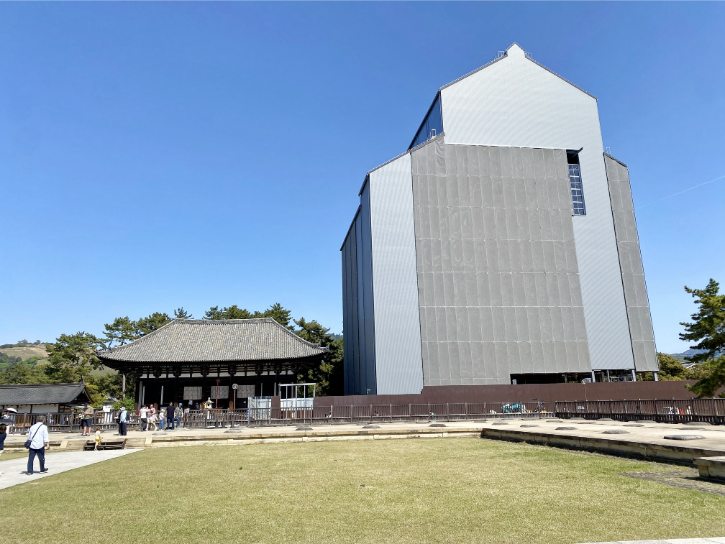
- What It Is: Kohfukuji is a famous Buddhist temple complex located in Nara Park, known for its historic pagoda, halls, and statues.
- History: Established in 669, moved to Nara in 710. It was important for the powerful Fujiwara family. Many buildings burned down and were rebuilt multiple times; the site is now part of a UNESCO World Heritage Site.
- Why Visit: You’ll see impressive architecture, ancient Buddha statues, and beautiful art. Highlights include the iconic five-story pagoda and the newly restored Central Golden Hall.
- Atmosphere: Relaxed and open environment. Deer roam freely nearby, making visits calm and enjoyable. No fences or gates, so you can easily explore at your own pace.
b. Central Golden Hall
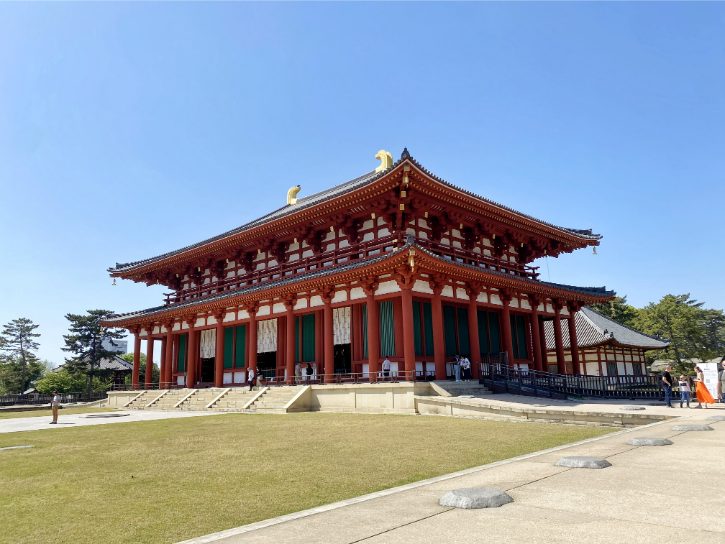
- Importance: Recently rebuilt (opened in 2018), now the temple’s main hall after being destroyed 300 years ago.
- Inside: Houses a large seated Shakyamuni Buddha statue (Historical Buddha) and four guardian statues (Four Heavenly Kings).
c. Eastern Golden Hall
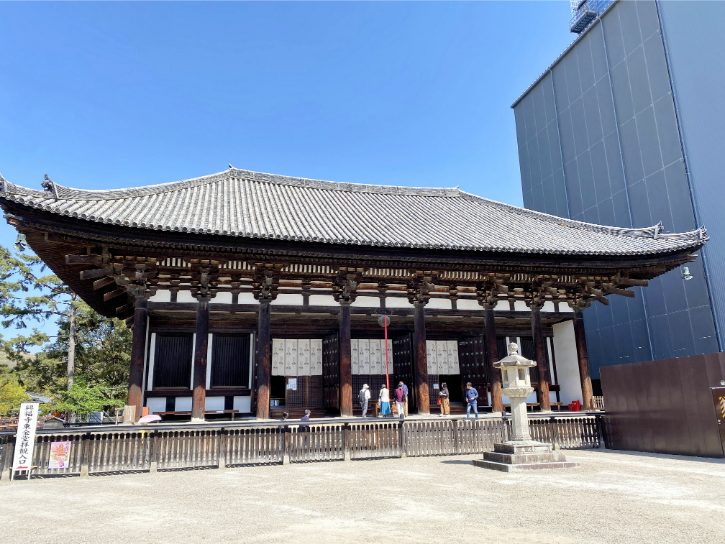
- Importance: Historical hall dating from 1415; survived many fires and is a National Treasure.
- Inside: Features a bronze Yakushi Buddha statue (Buddha of healing), with smaller statues nearby.
d. Southern Octagonal Hall
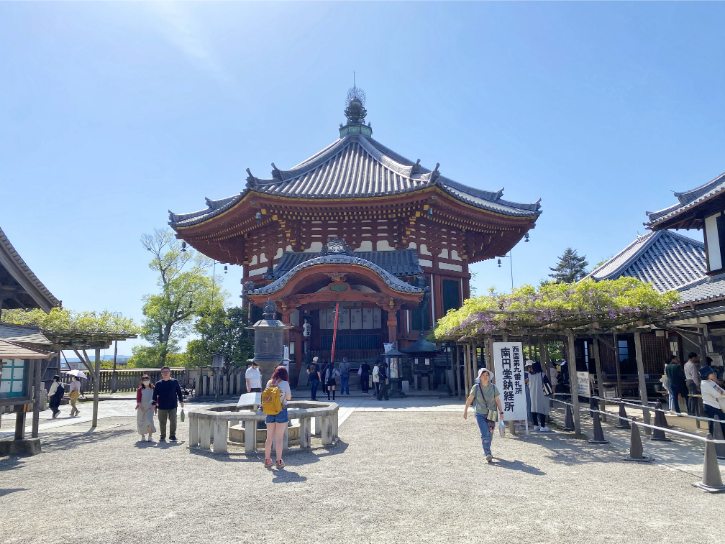
- Importance: Unique octagonal hall founded in 813, rebuilt in 1789. Famous stop on a Buddhist pilgrimage route.
- Inside: Contains a statue of Fukūkensaku Kannon (Bodhisattva of Compassion), but usually closed to visitors.
- Tips: Even though you can’t usually enter, it’s still worth visiting for photos.
e. Northern Octagonal Hall
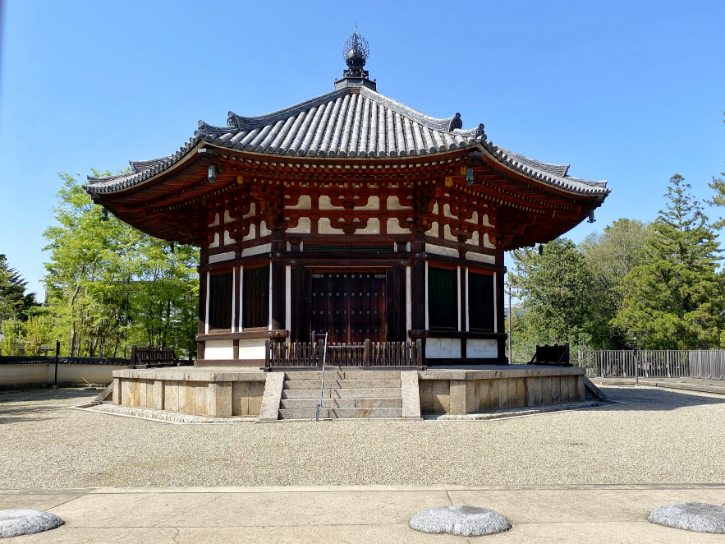
- Importance: Built in 1210; one of Kohfukuji’s oldest structures and a National Treasure.
- Inside: A statue of Maitreya Buddha (Buddha of the Future) and notable sculptures by the renowned artist Unkei. Usually closed to visitors.
- Tips: Quiet area with fewer visitors. Good for photography and enjoying a peaceful moment away from crowds.
f. How to Get to Kohfukuji Temple from JR Nara Station or Kintetsu Nara Station
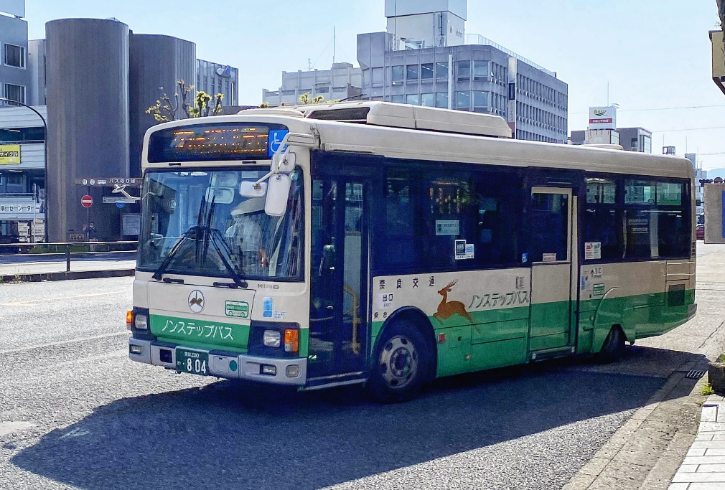
i. From JR Nara Station
- Nara City Loop Line Bus: Operates every 10 to 15 minutes. You can get a one-day unlimited pass for ¥600, which lets you use both loop buses – #1 (going anticlockwise) and #2 (going clockwise). Buy this pass at the Bus Information Center in JR Nara Station. Get off the bus at Kintetsu Nara Station and then walk to Kohfukuji Temple; it’s just a 5-minute walk.
- Public Bus #77: Operates every 30 minute. The bus fare is ¥250 from JR Nara Station (East Gate) to Kohfukuji Temple. Alight at Kenchozen Bus Stop and cross the street to reach the temple.
- Public Bus #97: Operates every 1 hour. The bus fare and drop-off location are the same as for bus #77.
- Red Gurutto Bus: Operates every 15 minutes and is only available on weekends. It begins service at 9:00 AM, with each ride costing ¥100. Alight from the bus at this spot, which is directly opposite the entrance of Kohfukuji Temple.
ii. From Kintetsu Nara Station
It’s a 5-minute walk from Kintetsu Nara Station to Kohfukuji Temple.
10:30 AM: Nara Deer Park
a. Overview
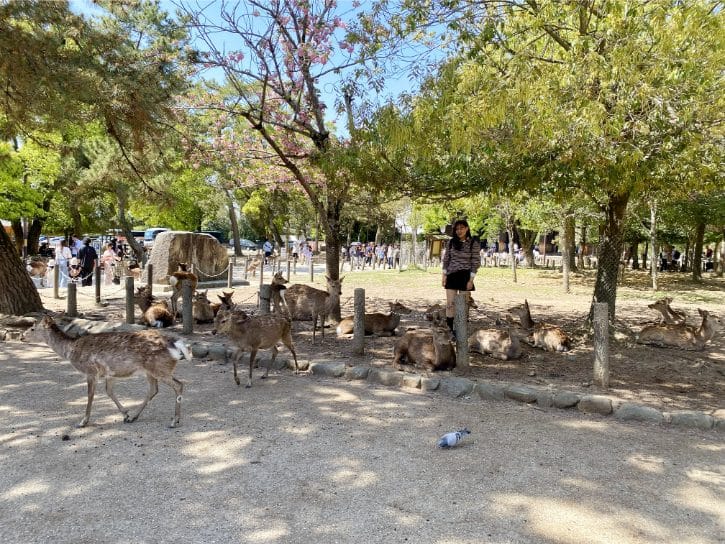
- What It Is: A large public park in Nara, Japan, famous for its friendly, free-roaming deer. Many wild deer live here.
- History: Deer have lived here since ancient times and were once considered sacred messengers of the gods. Today, they’re protected as a natural treasure.
- Why Visit: You can feed and interact with the friendly deer while exploring historic UNESCO temples and shrines. It’s a unique experience you won’t find elsewhere.
- Atmosphere: Relaxed and peaceful, even when crowded. The spacious green park allows deer to wander freely among visitors, creating a special connection between humans and wildlife.
b. What to Do
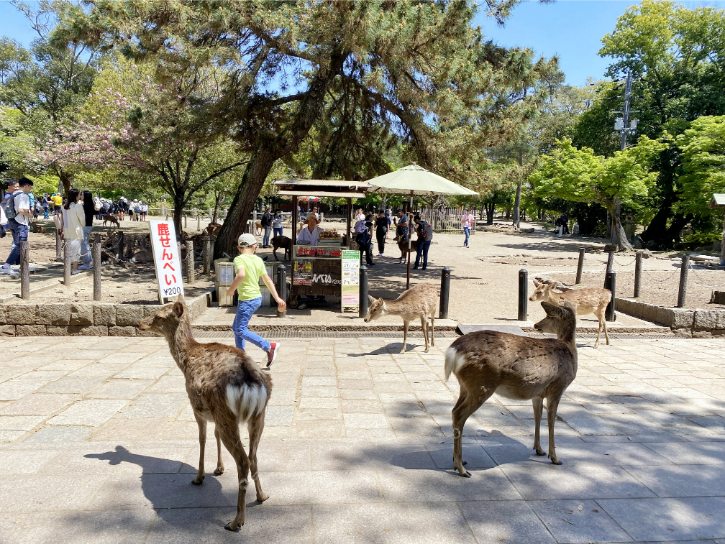
- Buy Deer Crackers: Only feed deer with special “shika senbei” crackers, sold in the park for around ¥200 per pack. Regular food can harm them.
- Take a Stroll: Enjoy the scenic walking paths and open spaces while watching the deer roam.
- Photography: Capture the unique moments with the deer and the park’s beautiful landscapes.
- Relax on a Bench: Sit back, enjoy the peaceful atmosphere, and watch the deer interact with visitors.
c. Tips for Feeding the Deer
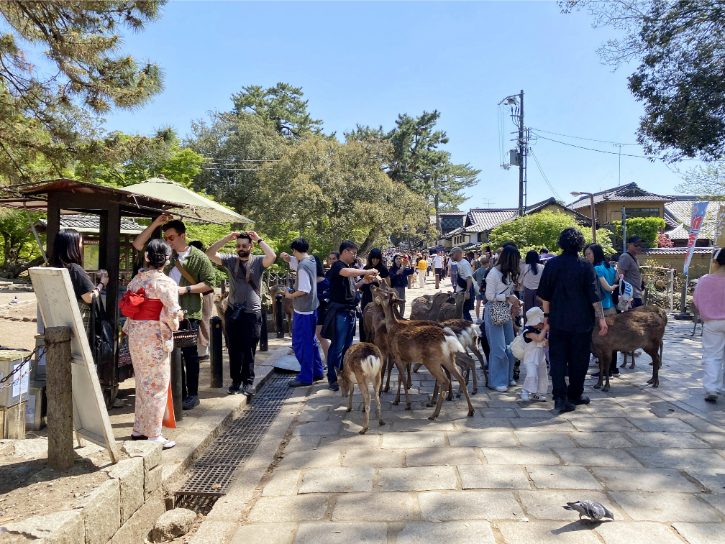
- How to Feed Deer: Hold crackers flat on your palm to avoid bites; when deer bow to you, feed them quickly after one or two bows and never tease them by withholding food.
- Stay Safe: Deer are usually gentle but can get pushy for crackers. Hide extra crackers, and if deer crowd around you, hold your empty hands up to show them you’re out of food.
- Respect the Animals: Don’t chase, hit, or pull deer. They’re wild animals and can bite, kick, or become upset if treated roughly.
- Protect Belongings: Deer may try to eat paper or bags. Secure maps, bags, and any belongings, as deer might nibble or snatch things from your hand.
- Cleanliness: Don’t litter as deer might accidentally eat trash. Wash or sanitize your hands after feeding or touching deer.
d. How to Get to Nara Deer Park from Kohfukuji Temple
It’s a 2-minute walk from Kohfukuji Temple to Nara Deer Park.
11:30 AM: Todaiji Nandaimon
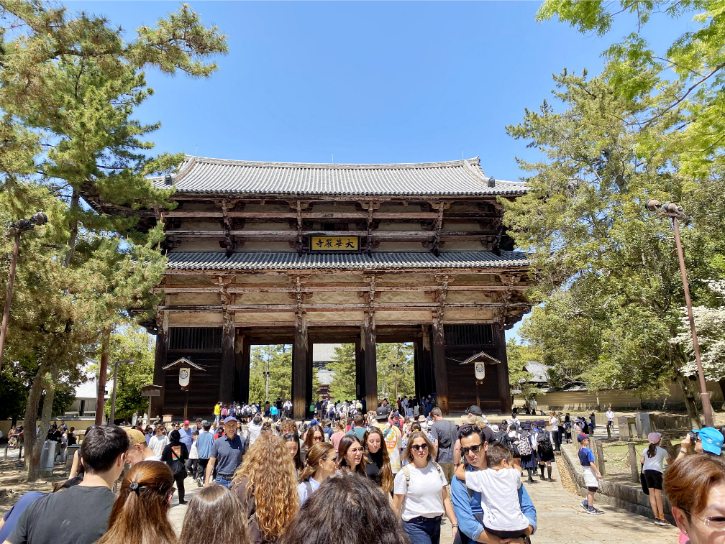
- What It Is: Nandaimon (“Great South Gate”) is the huge wooden entrance gate to Todaiji Temple in Nara, famous for its giant guardian statues.
- History: First built in the 8th century, rebuilt in 1203 after damage. Statues carved by famous sculptors Unkei and Kaikei.
- Why Visit: You can see one of Japan’s largest temple gate, impressive statues, and historic architecture.
- Atmosphere: The area around the gate is lively but comfortable. Deer roam freely, making your visit enjoyable and relaxed.
How to Get to Todaiji Nandaimon from Nara Deer Park
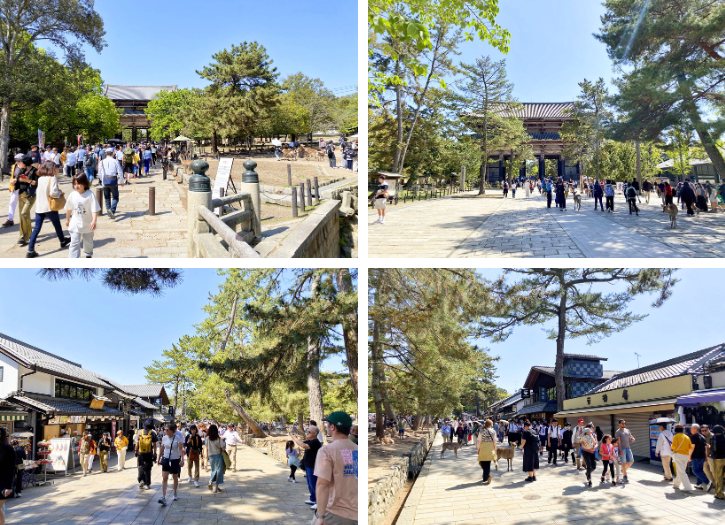
- Option 1 – On Foot: It’s an 11-minute walk from Nara Deer Park to Todaiji Nandaimon.
- Option 2 – Public Bus (#77 or #97): Take bus #77 or #97 from the Kenchozen Bus Stop to the Todaiji Daibutsuden Bus Stop in 3 minutes, then walk 4 minutes to Todaiji Nandaimon.
- Option 3 – Nara City Loop Line Bus #2: Take the Loop Line Bus #2 from the Kenchozen Bus Stop to the Todaiji-Daibutsuden/Kasugataisha-mae Bus Stop in 3 minutes, then walk 4 minutes to Todaiji Nandaimon.
11:40 AM: Todaiji Temple (The Great Buddha Hall)
a. Overview
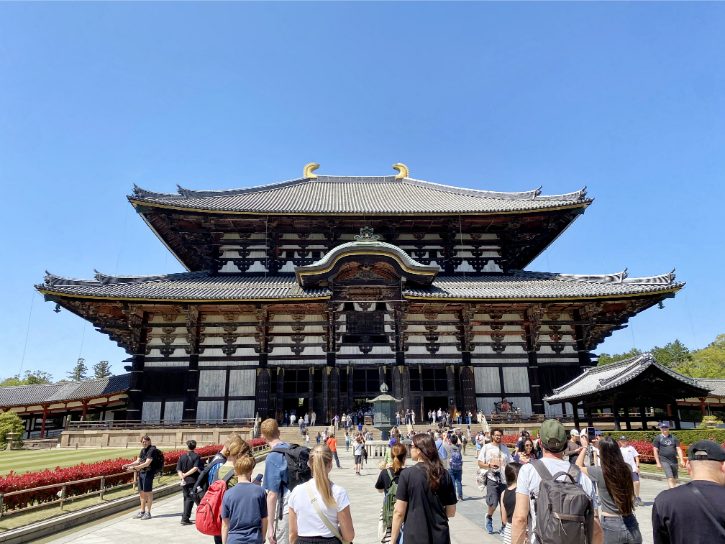
- What It Is: The Great Buddha Hall (Daibutsuden) is the main hall at Todaiji Temple in Nara. It houses one of the largest bronze Buddha statues in the world and is part of a UNESCO World Heritage site.
- History: Originally built in 752 to house a giant bronze Buddha. Destroyed and rebuilt several times due to wars and fires. The current hall dates from 1709 and, although huge, is only two-thirds of the original size.
- Why Visit: It’s Nara’s top attraction, famous for its impressive giant Buddha statue, historical significance, and beautiful wooden architecture. You’ll experience Japan’s history and culture firsthand.
- Atmosphere: Inside feels calm and respectful despite the crowds. Outside, you’ll find deer roaming freely, adding a playful charm.
b. Things to See
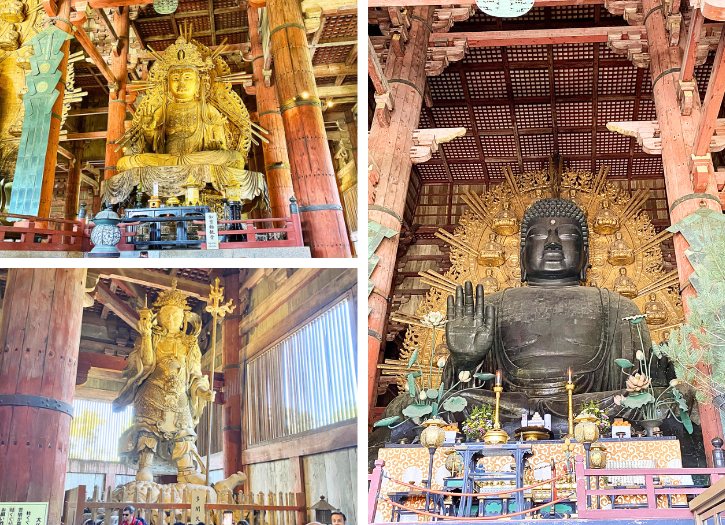
- Great Buddha Statue (Daibutsu): The main highlight, about 15 meters tall, seated in a peaceful pose. Walk around it to appreciate its size and craftsmanship.
- Bodhisattva Statues: Two smaller statues beside the Buddha, beautifully detailed and historically significant.
- Architecture: Look at massive wooden pillars and intricate ceiling details. Notice the golden rooftop decorations believed to protect against fire.
- Octagonal Lantern: Admire this ancient lantern from the time of Todaiji’s founding, featuring celestial musicians and lions on its panels.
c. Things to Do
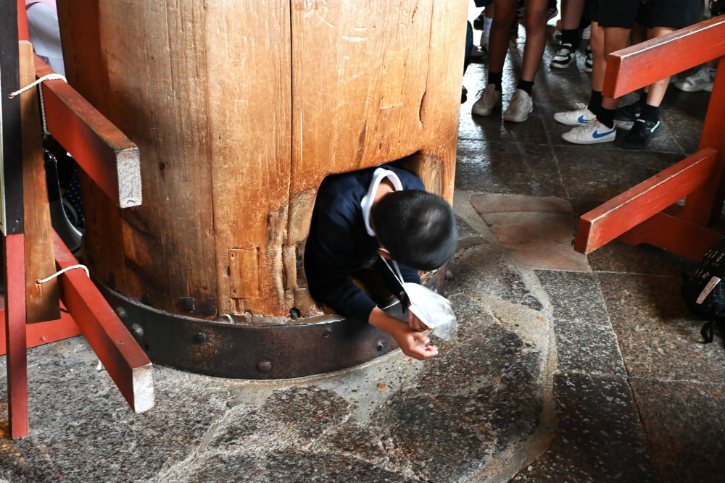
- Pillar with Hole (“Buddha’s Nostril”): Try crawling through this pillar’s hole near the Buddha. It’s said to grant good luck and is popular with visitors of all ages.
d. How to Get to Todaiji Temple from Todaiji Nandaimon
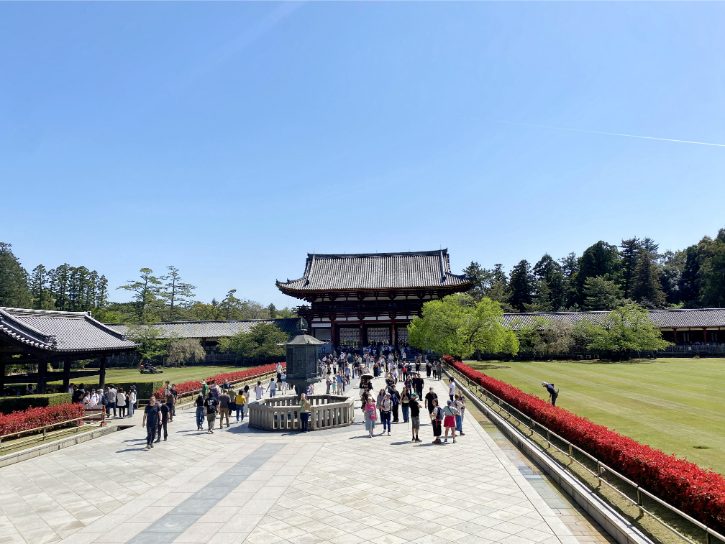
After passing through Todaiji Nandaimon, you will see Todaiji Temple directly ahead.
12:20 PM: Todaiji Shoro (Bell Tower)
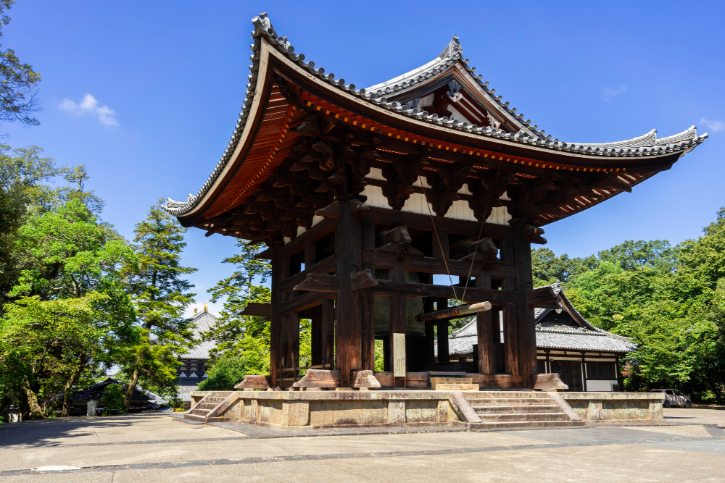
- What It Is:
- Bell Tower Location: A wooden structure within Todaiji Temple in Nara, housing a giant bell.
- Purpose: Traditionally used by monks to mark time or signal special ceremonies, especially at New Year.
- Huge Bronze Bell: One of Japan’s largest temple bells, nearly 4 meters tall and weighing about 26 tons.
- History:
- Original Bell: Made in the 8th century during the founding of Todaiji Temple.
- Rebuilt Tower: Current tower reconstructed around 1210 after original destroyed in conflicts.
- Why Visit:
- Ancient Artifact: Rare opportunity to see a huge, historic bell from ancient Japan.
- Photo-Friendly: Clear views of the bell, tower architecture, and peaceful surroundings ideal for pictures.
- Atmosphere:
- Peaceful Setting: Calm area, perfect for taking a relaxing break away from busy crowds.
- Unique Sound: Famous for its deep, resonating tone, especially memorable if you hear it rung.
- Natural Surroundings: Located near trees and greenery, sometimes visited by Nara’s famous deer.
How to Get to Todaiji Shoro from Todaiji Temple
It’s a 4-minute walk from Todaiji Temple to Todaiji Shoro.
12:30 PM: Having Lunch at Todaiji Emado Chaya
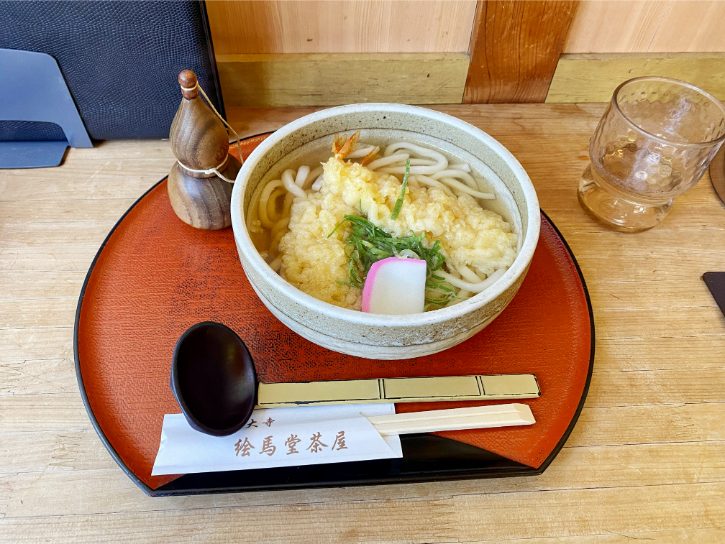
- What They Sell: Todaiji Emado Chaya offers Japanese casual meals, noodles (udon, soba), rice bowls, traditional sweets, snacks, tea, coffee, and ice cream. Good for quick bites or a simple lunch.
- Must-Try Dishes:
- Udon/Soba Set Meal: Includes udon or soba noodles, rice with vegetables, Japanese pickles, and side dishes. Choose toppings like deep-fried tofu or shrimp tempura.
- Yamato no Chagayu: Traditional rice porridge cooked in roasted tea, served with pickles; famous local dish in Nara.
- Karaage Don: Deep-fried chicken with egg served over rice; available individually or as a set with noodles.
- Ebi-Ten Don: Shrimp tempura with egg served over rice; can be ordered alone or as a set with noodles.
- Chicken Teriyaki Don: Grilled chicken with teriyaki sauce served on rice; also offered individually or with noodles as a set.
- Price Range: Most dishes range from ¥950 to ¥1,150 per meal. The noodle set meal costs around ¥1,000. Affordable spot near Todaiji Temple.
How to Get to Todaiji Emado Chaya from Todaiji Shoro
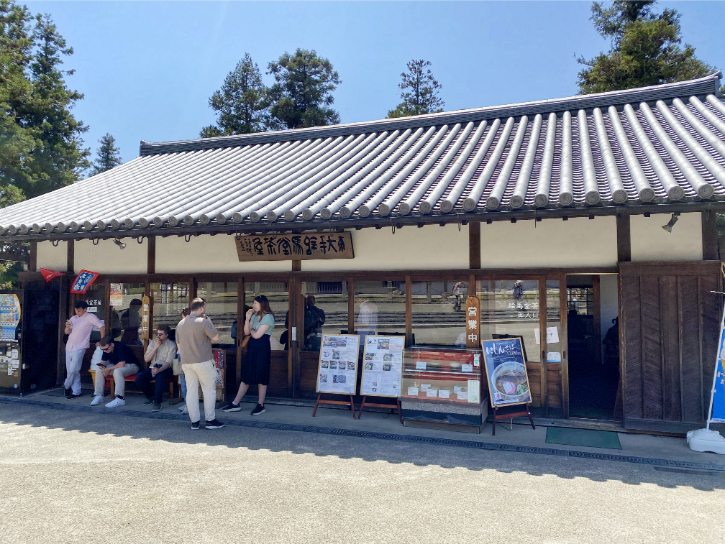
It’s a 2-minute walk from Todaiji Shoro to Todaiji Emado Chaya.
1:30 PM: Todaiji Nigatsudo Hall
a. Overview
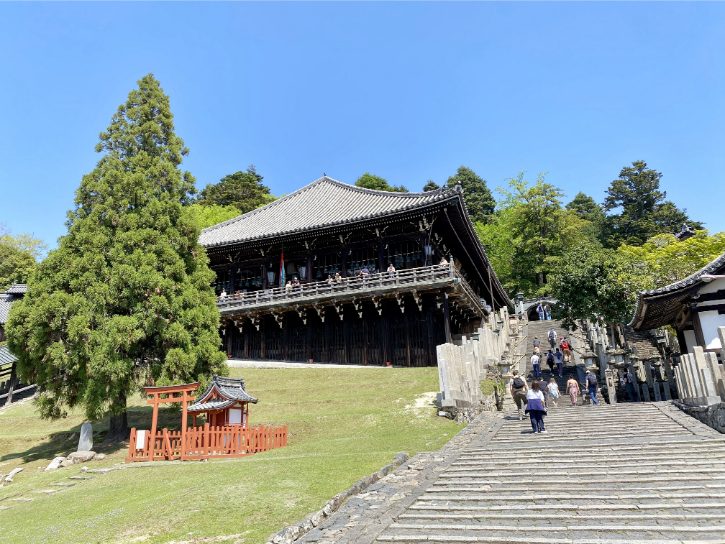
- What It Is: Nigatsudo Hall (“Second Month Hall”) is a historic wooden temple within the Todaiji complex in Nara, famous for its views and traditional events, particularly the Omizutori fire ceremony each March.
- History: Built in 752 AD, Nigatsudo Hall is famous for the Omizutori Festival, a sacred Buddhist ritual held every March for over 1,250 years.
- Why Visit: Perched on a hillside, the hall offers panoramic views of Nara, including the city and surrounding mountains.
- Atmosphere: Calm, peaceful, and spiritual. It feels historic with old wooden architecture, stone lanterns, and quiet surroundings. Particularly beautiful at sunset with lanterns lighting up pathways.
b. Things to Do and See
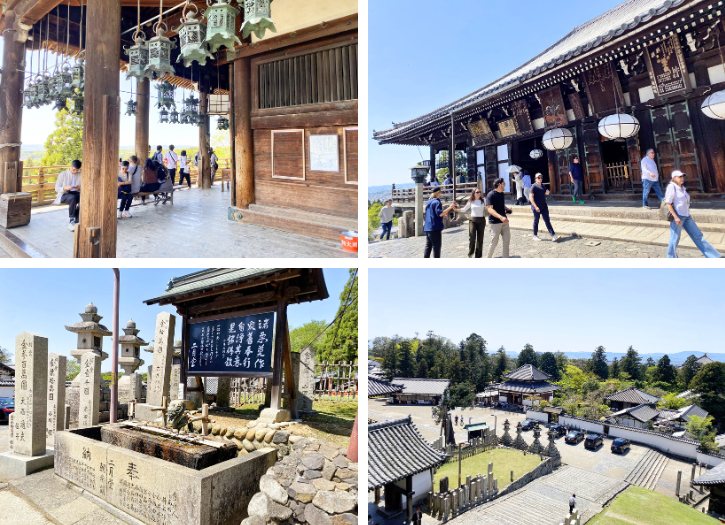
- Omizutori Ceremony (March 1–14): Each night around 7:00 PM, monks wave huge flaming torches from the balcony. March 12 has the largest display. Arrive at least an hour early due to large crowds.
- Balcony Viewpoint: Offers beautiful views over Nara city, ideal for photos, especially around sunset.
- Inside the Hall: See lanterns, prayer plaques, and a peaceful interior.
- Stone Pathways: Scenic paths lined with stone lanterns lead up to the hall. Especially picturesque during spring (cherry blossoms) and autumn (fall leaves).
c. How to Get to Todaiji Nigatsudo Hall from Todaiji Emado Chaya
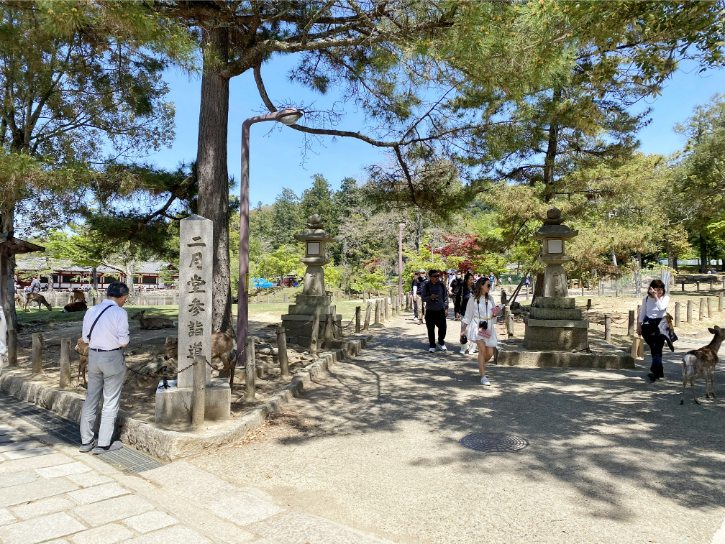
It’s a 2-minute walk from Todaiji Emado Chaya to Todaiji Nigatsudo Hall.
3:00 PM: Kasuga Taisha
a. Overview
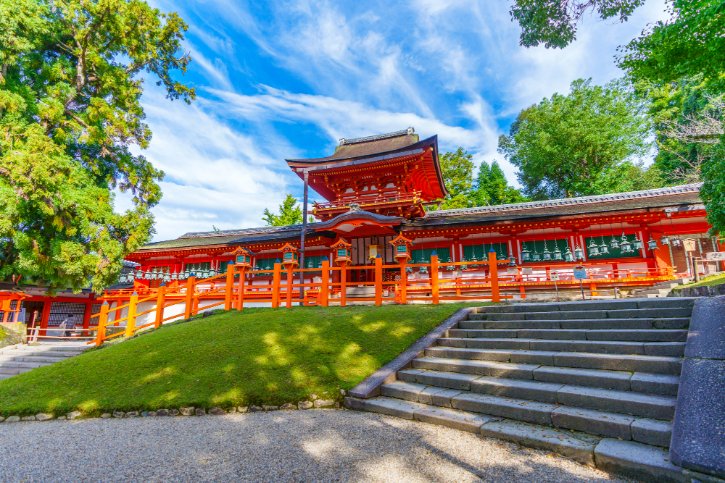
- What It Is: Kasuga Taisha is a famous Shinto shrine in Nara, known for its Kasuga-zukuri architecture (vermillion pillars, cypress bark roofs) and over 3,000 lanterns. It’s part of a UNESCO World Heritage site.
- History: Built in 768 by the Fujiwara family. It’s linked to legends about sacred deer, considered messengers of the shrine’s gods.
- Why Visit: Famous for thousands of lanterns, the shrine’s vermillion buildings, and Japan’s oldest wisteria tree (700+ years old).
- Atmosphere: Calm, spiritual, and peaceful. Surrounded by old forests, lantern-lined paths, and friendly deer roaming freely.
b. Things to Do and See
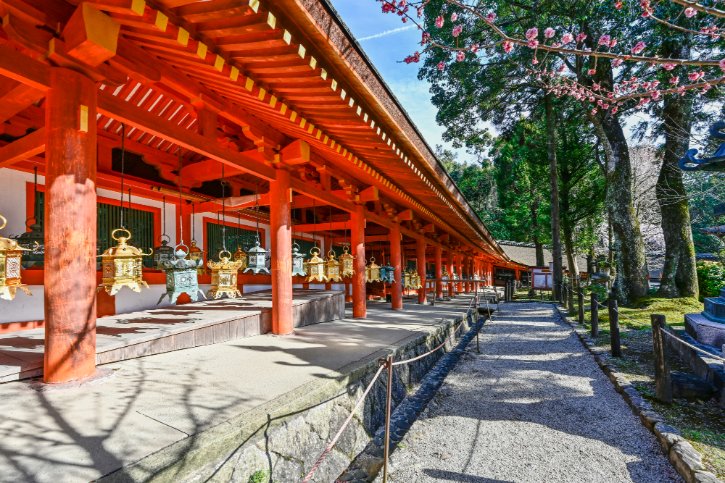
- Kasuga-zukuri Architecture: Admire the main hall’s distinctive sloping roofs and intricate carvings.
- Lanterns (Stone and Bronze): The shrine grounds feature about 3,000 historic lanterns. Stone lanterns line the pathways, while bronze lanterns hang from buildings. Special lighting events occur twice yearly (February 3 and August 14-15).
- Inner Sanctuary (¥700): This paid entry area includes a special hall filled with lit lanterns, giving visitors a glimpse of the festival atmosphere. Highly recommended for a unique experience.
- Kasugataisha Museum (¥500): The Treasure House displays historical artifacts including armor, swords, and artwork. Worth visiting for history enthusiasts.
- Manyo Botanical Garden (¥500): Famous for its wisteria flowers, best viewed from late April to May. Home to Japan’s oldest wisteria tree, over 700 years old.
- Kasuga Ninai Jaya (Garden Cafe): A traditional Japanese-style cafe near the entrance to the Manyo Botanical Garden. Offers local specialties like Manyo-gayu (rice porridge with seasonal greens), Kakinoha Sushi, and traditional sweets.
c. How to Get to Kasuga Taisha from Todaiji Nigatsudo Hall
It’s a 15-minute walk from Todaiji Nigatsudo Hall to Kasuga Taisha.
4:30 PM: Higashimuki Shopping Street
a. Overview
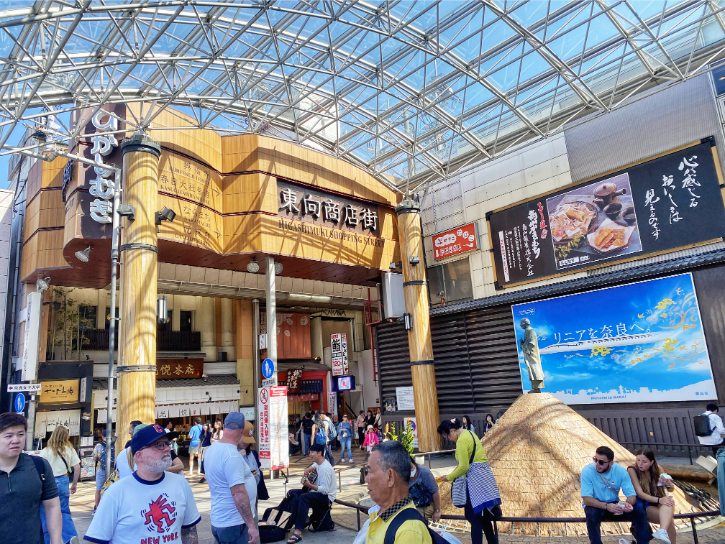
- What It Is: A popular, covered shopping arcade right outside Kintetsu Nara Station, lined with about 80 shops, eateries, and cafes.
- History: Established around 1,300 years ago; name means “facing east” because original buildings faced Kofukuji Temple.
- Why Visit: Convenient spot near popular attractions like Nara Park and Kofukuji Temple; great for shopping, eating, and experiencing local culture.
- Atmosphere: Lively and welcoming; busy with both locals and tourists. Pedestrian-only street makes it safe and enjoyable to explore at your own pace.
b. Things to Do
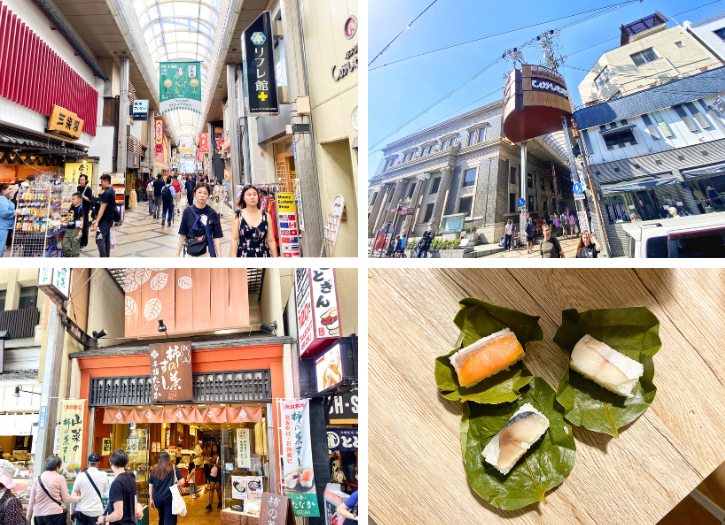
- Kakinohasushi Hompo Tanaka: Renowned shop serving delicious kakinoha-zushi (bite-sized sushi wrapped in persimmon leaves). Perfect for a unique snack.
- Yamazakiya Honten: Well-known shop specializing in authentic Nara-zuke, vegetables pickled in sake lees. Ideal place to taste and buy traditional Nara pickles.
- Momoshiki: Popular restaurant specializing in Yamato beef dishes such as sukiyaki and beef mabushi. Great spot to experience Nara’s local wagyu beef specialties.
- Nakatanidou: Famous mochi shop known for fresh yomogi mochi (mugwort-flavored rice cakes) and exciting mochi-pounding demonstrations.
- Deer-themed Souvenirs: Many shops sell cute deer-related items like plush toys, keychains, socks, and headbands with antlers.
- Mafu Okai: Traditional store selling handmade linen products like bags, towels, and textiles, great for authentic local gifts.
- Daiso (100-yen Shop): Budget-friendly place to buy practical souvenirs, snacks, stationery, and small gifts.
- Dining Options: Plenty of casual eateries serve Japanese dishes like noodles, ramen, curry, plus cafes and a few Western-style options.
c. How to Get to Higashimuki Shopping Street from Kasuga Taisha
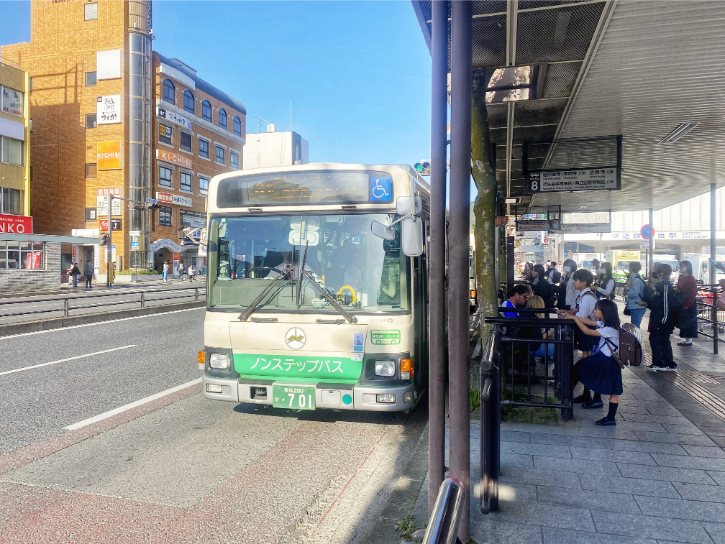
- Option 1 – Public Bus (#78 or #98): Take bus #78 or #98 from Kasuga Taisha Honden Bus Stop to Kintetsu Nara Station Bus Stop in 7 minutes, then walk 1 minute to Higashimuki Shopping Street.
- Option 2 – Nara City Loop Line Bus #1: Walk 10 minutes from Kasuga Taisha to the Kasuga Taisha Omotesando Bus Stop. From there, take the Loop Line Bus #1 to Kintetsu Nara Station Bus Stop in 6 minutes, then walk 1 minute to Higashimuki Shopping Street.
5:30 PM: Nakatanidou Mochi Shop
a. Overview
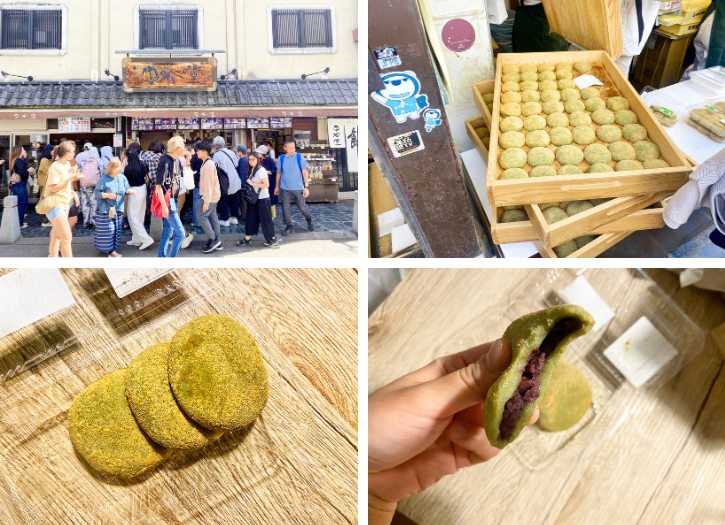
- What It Is: Nakatanidou Mochi Shop is a small, popular mochi shop located at the end of Higashimuki Shopping Street in Nara City, famous for freshly handmade rice cakes.
- History: Founded in 1992 by Mitsuo Nakatani; famous after winning Japan’s mochi-pounding competitions (2005-2006). Now widely known from TV and viral online videos.
- Why Visit: Unique chance to watch a fast-paced mochi-making performance. Friendly, authentic atmosphere; popular with locals and visitors.
b. Things to Do
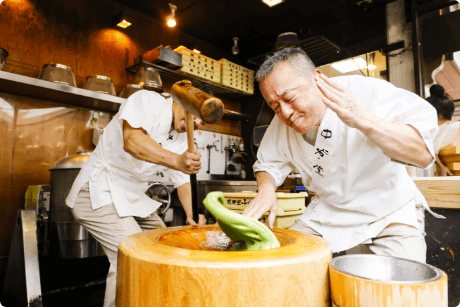
- Watch Mochi-Pounding: Free live shows performed frequently (every 30 minutes when crowded). Two craftsmen pound rice into mochi at high speed, chanting in rhythm. Have your camera ready; it’s quick and impressive.
- Try Yomogi Mochi: Signature green-colored mochi flavored with yomogi (mugwort herb), filled with sweet red bean paste, and dusted with kinako powder (roasted soybean).
- Pricing: Each yomogi mochi costs ¥200 (cash only). Boxes for takeaway are also available.
- Tips for Eating: Best enjoyed immediately while warm and soft. If taking away, eat the same day for optimal taste and texture.
c. How to Get to Nakatanidou Mochi Shop from Higashimuki Shopping Street
It’s a 2-minute walk from Higashimuki Shopping Street to Nakatanidou Mochi Shop, located at the end of the shopping street.
6:00 PM: Dine at Tonkatsu Ganko Nara
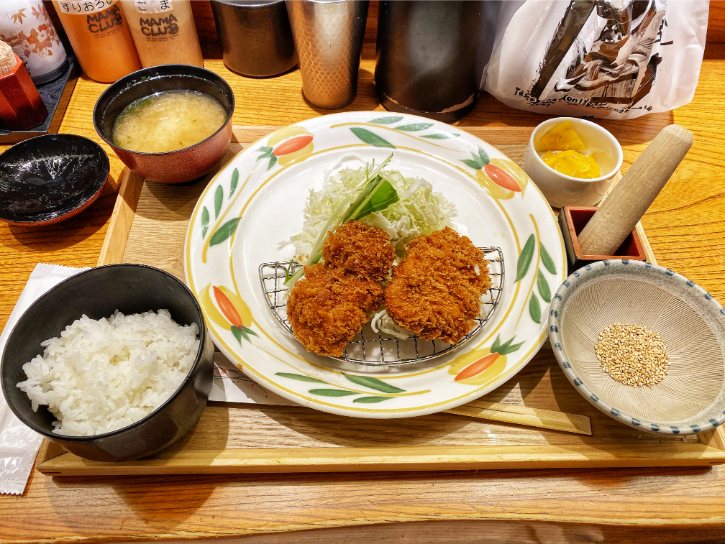
- What They Sell:
- Main Dish: Tonkatsu Ganko Nara offers Tonkatsu (crispy, deep-fried pork cutlets), served as complete meals (teishoku).
- Sides Included: All meals come with rice, miso soup, pickles, and shredded cabbage.
- Other Choices: Besides pork, you can get fried shrimp (ebi fry) or fried fillet.
- Must-Try Dishes:
- Classic Tonkatsu Set: Juicy pork loin cutlet meal, the restaurant’s specialty.
- Mixed Set: Combination meal with pork cutlet and jumbo fried shrimp.
- Kurobuta Pork Cutlet: Premium black pork loin, extra tender and flavorful.
- Price Range:
- Regular Sets: Typically cost between ¥1,200–¥2,000 per person.
- Extras: Unlimited refills for rice, miso soup, and cabbage included in your meal price.
How to Get to Tonkatsu Ganko Nara from Nakatanidou Mochi Shop

It’s a 2-minute walk from Nakatanidou Mochi Shop to Tonkatsu Ganko Nara. The restaurant is located on Higashimuki Shopping Street.
7:00 PM: Returning to Osaka or Kyoto
a. Departing from JR Nara Station
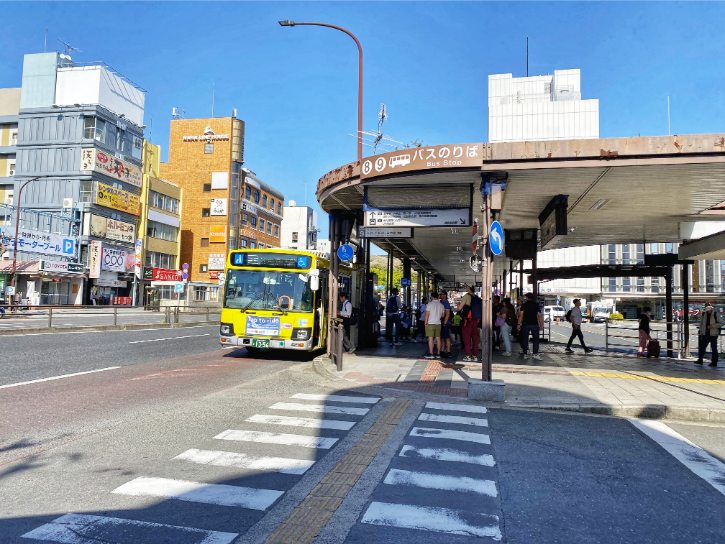
If you’re departing from JR Nara Station back to Osaka or Kyoto, take the Nara City Loop Line Bus #1 (bus stop), public bus #28 (bus stop), or public bus #135 (bus stop) directly from Kintetsu Nara Station to JR Nara Station.
For the return trip, simply reverse the route you took to reach Nara. See the guide at the beginning of this article for detailed instructions.
b. Departing from Kintetsu Nara Station

If you’re departing from Kintetsu Nara Station back to Osaka or Kyoto, it’s just a 1–2 minute walk from Tonkatsu Ganko Nara (in Higashimuki Shopping Street) to the station.
For your return journey, simply reverse the route you used to reach Nara. See the guide at the beginning of this article for detailed instructions.
Related Posts
Photo Credit:
Photos by PIXTA

